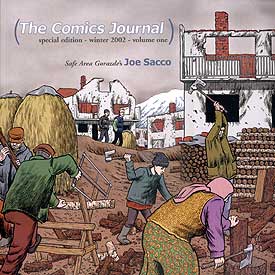
|
"The Comics Journal Special Edition: Winter 2002" (Fantagraphics Books; 156pp.; $29.95) has "Cartoonists on Cartooning" as the theme. This applies mostly to the second half of the book which consists of comix -- or the "carrot" part. "The stick," written essays, histories and an interview with Joe Sacco, author of "Safe Area Gorazde," has been smartly designed to introduce newcomers to critical writing about comix. It reads like a "Comics Journal" for beginners, which has both good and bad points.
For the most part none of the articles require prior knowledge of comix past or present, though they may require some patience. Jim Woodring, author of the comicbook "Frank," writes a personal appreciation of the early gag cartoonist T. S. Sullivant who, "posed his characters in ways never seen before or since." Other historical essays include one about Bill Holman's "Smokey Stover" strip from the 1930s. Noticeably the generous examples of Holman's screwball "YOWSA!" of a strip tell you nearly as much as the essay's academic run-on. (Sample: "Holman's desultory recklessness as he periodically disassembled his characters and riddled his sets and his innocuous ruthlessness echo" etc. etc.) Of the essays, Gregory Cwiklik's, "What's Wrong with Comics Today," sums up the entire editorial stance of the Journal in few pages. Neophytes may be more shocked at its scorched-earth rhetoric than long-time readers, but it still makes for a satisfying explosion.
The centerpiece of the book, an interview with Joe Sacco, should not be missed. Traveling to Palestine and the former Yugoslavia Sacco has pioneered a new kind of journalism that uses comix to visualize dramatic, personal stories that otherwise had no documentation. Focusing on his trips to Bosnia, the basis for his remarkable "Safe Area Gorazde," the interview works simultaneously as thumbnail history of the Balkans crises and how an artist, particularly a comix artist, works. "To me the challenge of it, the art it," Sacco says," is getting people to care by making those characters human. And that's done by drawing them, showing their faces, showing their homes and accurately depicting what sort of personalities they were."
 From Sam Henderson's contribution to "Cartoonists on Cartooning"
From Sam Henderson's contribution to "Cartoonists on Cartooning" |
The comix part of the book, "Cartoonists on Cartooning," includes contributions from a number of artists we hardly hear from anymore. Robert Crumb, for example, submits a simulacrum of himself as "Harold," an aging cartoonist with his mind more on prostate cancer than on making art. Justin Green, another underground original, makes a welcome appearance with his typically personal story that starts with a childhood correspondence course in cartooning and ends with accidentally drinking paint thinner. Other contributors include Chris Ware, Los Bros. Hernandez, Carol Lay, Dave Sim (with a refreshingly straight-forward appreciation of Alex Raymond), Jessica Abel and about 30 others, all of them "names." Maybe my favorite is Phoebe Glockner's anti-comic, "I Hate Comics." "I mean just look at this self-conscious crap," she begins, filling her panels with almost nothing but text. But it's still a comic, isn't it?
"The Comics Journal Special Edition" looks great and makes a case for a broadly-appealing high-end journal with a comix focus. Hopefully future issues will attract a quality of critical writing to match the presentation. With more and more contemporary writers openly embracing the art form we should no longer have to look to George Seldes' seventy-five-year-old essay on the delights of "Krazy Kat" as the height of comics criticism. Aimed at regular bookstores, with its combination of both actual comix as well as comix thought and history, perhaps this series of "Special Edition" books will help raise comix out of its artistic ghetto.
"The Comics Journal Special Edition: Winter 2002" can be found at better comicbook stores and regular bookstores alike.
Full Disclosure: In the past I have contributed a few articles to the monthly edition of "The Comics Journal," but not since beginning this column.
TIME.comix will be taking a week off to better celebrate the delights of the U.S. presidency
